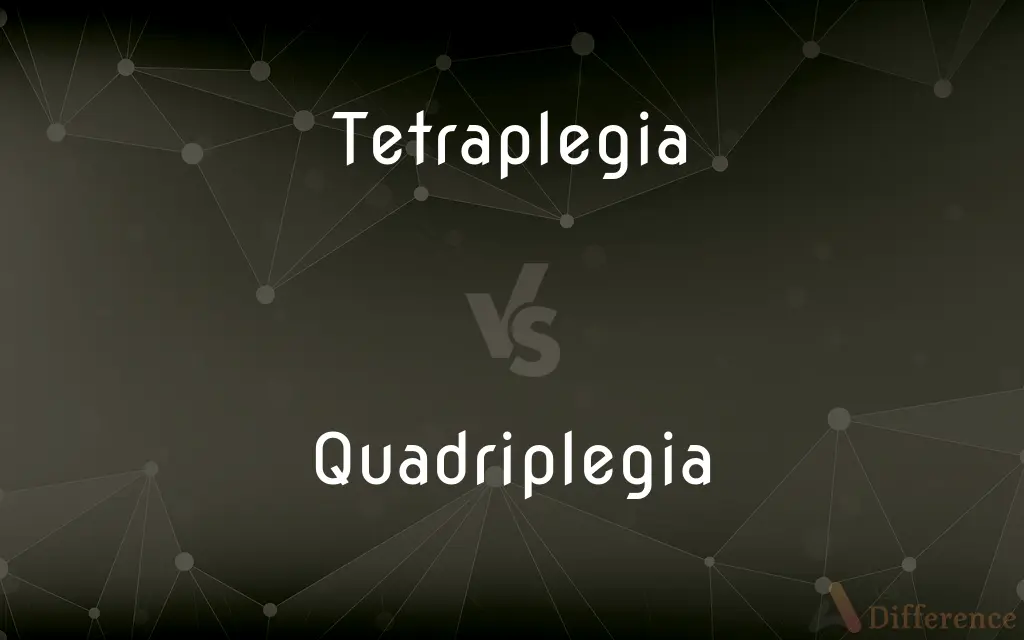Tetraplegia vs. Quadriplegia — What's the Difference?
By Urooj Arif & Maham Liaqat — Updated on April 28, 2024
Tetraplegia and quadriplegia describe paralysis of all four limbs; "tetraplegia" is preferred in medical terminology, while "quadriplegia" is more common in general use.

Difference Between Tetraplegia and Quadriplegia
Table of Contents
ADVERTISEMENT
Key Differences
Tetraplegia, often used in medical and clinical settings, refers to the paralysis of all four limbs and the torso, typically resulting from damage to the spinal cord. Whereas quadriplegia, more commonly used in everyday language, describes the same condition, emphasizing the involvement of all four limbs without specifically mentioning the torso.
Tetraplegia is derived from Greek, where 'tetra' signifies four and 'plegia' means paralysis, indicating a more global usage in the international medical community. On the other hand, quadriplegia comes from Latin roots with 'quadri' also meaning four, reflecting a terminology more familiar to the general public, particularly in the United States.
In medical documentation, tetraplegia is classified under various levels based on the point of spinal cord injury, providing precise diagnostic and rehabilitation frameworks. Whereas, the term quadriplegia is often used in legal and social contexts to describe disability status and in discussions about patient care without detailed medical classification.
The choice of terminology can influence patient care protocols, with tetraplegia often leading to more specific interventions according to the level of injury. On the other hand, the use of quadriplegia might focus more on the impairment and functional rehabilitation aspects rather than the detailed anatomical injury site.
Professionals in healthcare tend to use tetraplegia to ensure consistency across international medical communications, which facilitates research and global discussions. Conversely, quadriplegia remains prevalent in non-medical settings, such as media and personal communication, where specific medical details are less crucial.
ADVERTISEMENT
Comparison Chart
Terminology Origin
Greek ('tetra' + 'plegia')
Latin ('quadri' + 'plegia')
Usage
Medical, international
General, more common in U.S.
Implication
Paralysis of four limbs and torso
Paralysis of four limbs, general emphasis
Contexts
Medical classification, treatment plans
Legal, social, rehabilitation
Communication
Preferred in professional healthcare
Used in everyday conversation
Compare with Definitions
Tetraplegia
Paralysis affecting the arms, legs, and body trunk.
After the accident, he was diagnosed with tetraplegia.
Quadriplegia
A condition of being paralyzed in all four limbs.
Quadriplegia affects her ability to perform physical tasks independently.
Tetraplegia
Requires extensive rehabilitation and adaptive technologies for mobility.
She uses adaptive devices to manage daily activities due to tetraplegia.
Quadriplegia
Leads to significant changes in lifestyle and needs for assistance.
Life with quadriplegia demands changes in home and work environments.
Tetraplegia
Classified by the level of spinal injury in medical terms.
His tetraplegia is classified as C4, indicating the site of spinal cord damage.
Quadriplegia
Focuses on improving quality of life through various therapies.
He undergoes regular physiotherapy to improve his condition with quadriplegia.
Tetraplegia
Often associated with loss of both sensation and motor function below the neck.
Tetraplegia can involve complete or incomplete loss of sensory functions.
Quadriplegia
Often discussed in terms of patient care and legal rights.
She advocates for better resources for people living with quadriplegia.
Tetraplegia
A medical condition resulting from significant spinal cord injury.
Tetraplegia requires comprehensive multidisciplinary management.
Quadriplegia
Can result from traumatic injury or disease affecting the spinal cord.
Quadriplegia in this case was caused by a severe spinal cord injury.
Tetraplegia
Tetraplegia, also known as quadriplegia, is paralysis caused by illness or injury that results in the partial or total loss of use of all four limbs and torso; paraplegia is similar but does not affect the arms. The loss is usually sensory and motor, which means that both sensation and control are lost.
Quadriplegia
Complete paralysis of the body from the neck down. Also called tetraplegia.
Tetraplegia
See quadriplegia.
Quadriplegia
Paralysis from the neck down.
Tetraplegia
Paralysis of all four limbs.
Quadriplegia
Paralysis of all four limbs.
Tetraplegia
Complete paralysis from below the jaw.
Quadriplegia
Paralysis of both arms and both legs
Common Curiosities
What types of medical specialists are involved in the care of individuals with tetraplegia or quadriplegia?
Specialists include neurologists, physiatrists, physical therapists, occupational therapists, and sometimes psychologists or psychiatric professionals.
Is there a difference in treatment approaches between tetraplegia and quadriplegia?
Treatment approaches are generally similar, focusing on maximizing patient function and independence, though medical terminology (tetraplegia) might indicate a more detailed, specific medical protocol.
What role do occupational therapists play in the lives of patients with tetraplegia and quadriplegia?
Occupational therapists help patients develop skills for daily living, recommend home modifications, and facilitate the use of adaptive equipment.
What are the main causes of tetraplegia and quadriplegia?
The main causes include traumatic injuries from accidents, falls, or violence, and diseases such as polio or spinal tumors.
Are tetraplegia and quadriplegia always permanent conditions?
While both conditions often result in permanent disability, the extent of recovery can vary based on the severity of the spinal injury and the effectiveness of rehabilitation.
How do tetraplegia and quadriplegia affect an individual’s daily life?
These conditions significantly impact daily activities, requiring adaptations for personal care, mobility, and communication.
Can individuals with tetraplegia or quadriplegia lead independent lives?
Many can lead increasingly independent lives with the aid of adaptive technologies, personal assistants, and supportive environments.
What is the impact of tetraplegia and quadriplegia on employment?
Employment impacts vary; some individuals can work in adapted settings or roles, while others may be unable to work.
How do family members typically support a person with tetraplegia or quadriplegia?
Family support can include physical care, emotional support, and assistance with medical needs and navigating disability services.
What adaptive technologies benefit individuals with tetraplegia or quadriplegia?
Technologies include power wheelchairs, voice-activated devices, adaptive computer equipment, and environmental control units.
What research advancements are being made in the treatment of tetraplegia and quadriplegia?
Current research includes stem cell therapies, neural interface technologies, and improved rehabilitation techniques that aim to restore function and improve quality of life.
How does spinal cord injury level affect the prognosis in tetraplegia or quadriplegia?
Higher spinal cord injuries (closer to the brain) typically result in more severe paralysis and greater loss of function.
What psychological support is available for individuals with tetraplegia or quadriplegia?
Psychological support can include counseling, support groups, and sometimes psychiatric care to help manage the emotional and mental health challenges associated with severe paralysis.
How do legal definitions of disability relate to tetraplegia and quadriplegia?
Both conditions are recognized as disabilities under the law, which can affect eligibility for disability benefits, accommodations, and protections.
How do tetraplegia and quadriplegia influence social interactions and relationships?
These conditions can pose challenges for social interaction and relationships, but with proper support and understanding, many individuals maintain active, fulfilling social lives.
Share Your Discovery

Previous Comparison
Turnip vs. Radish
Next Comparison
Carriage vs. FreightAuthor Spotlight
Written by
Urooj ArifUrooj is a skilled content writer at Ask Difference, known for her exceptional ability to simplify complex topics into engaging and informative content. With a passion for research and a flair for clear, concise writing, she consistently delivers articles that resonate with our diverse audience.
Co-written by
Maham Liaqat















































